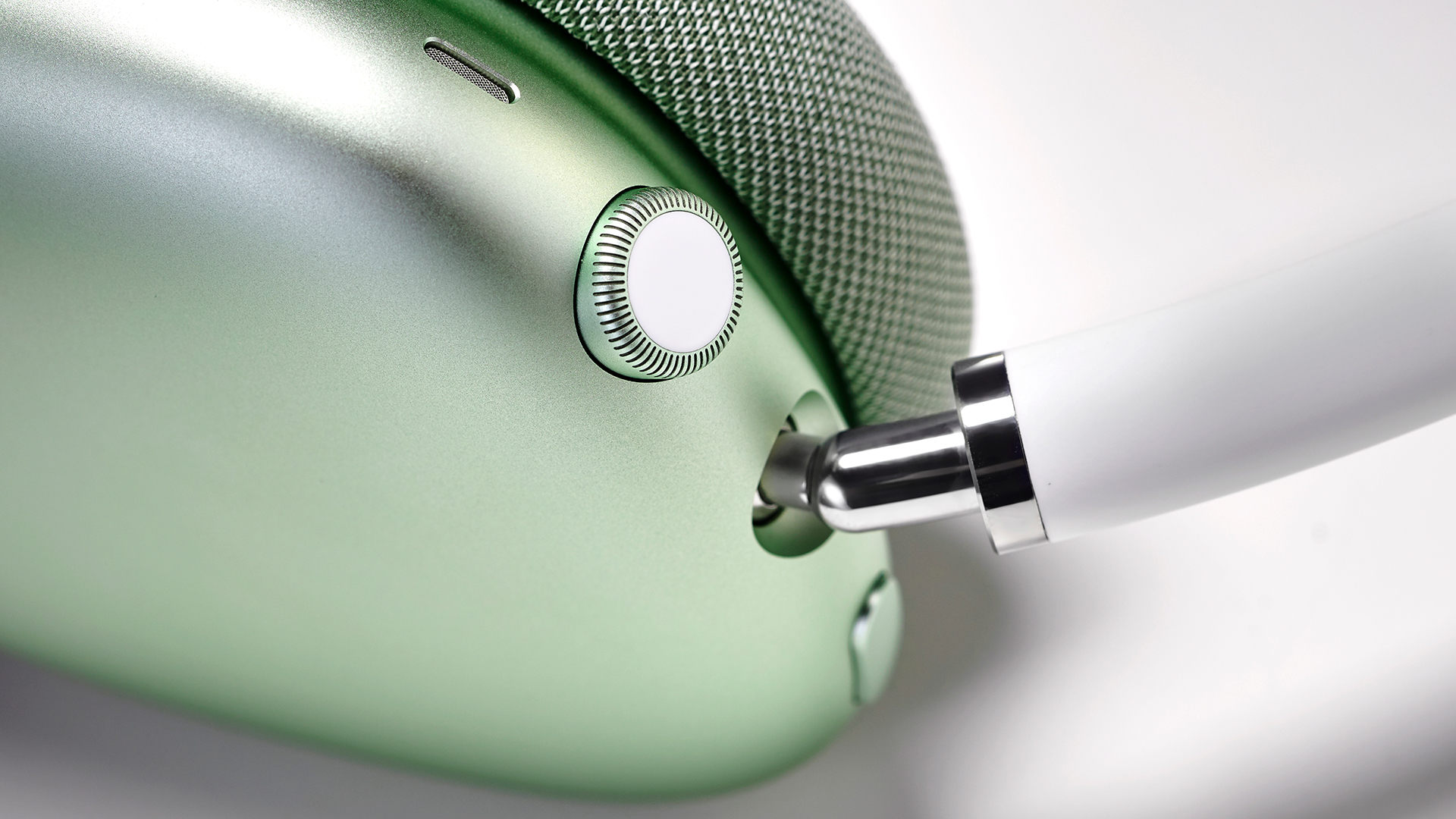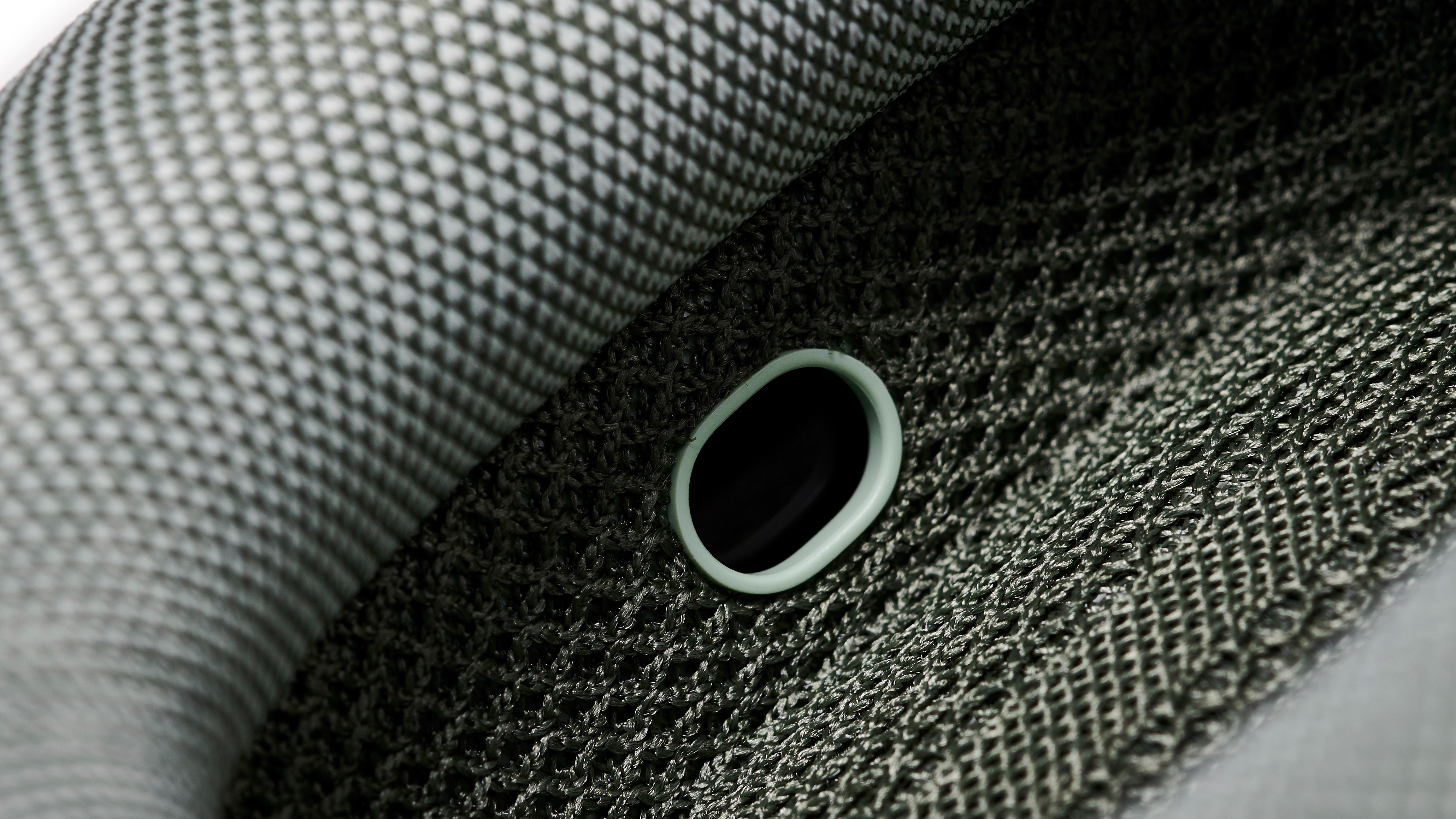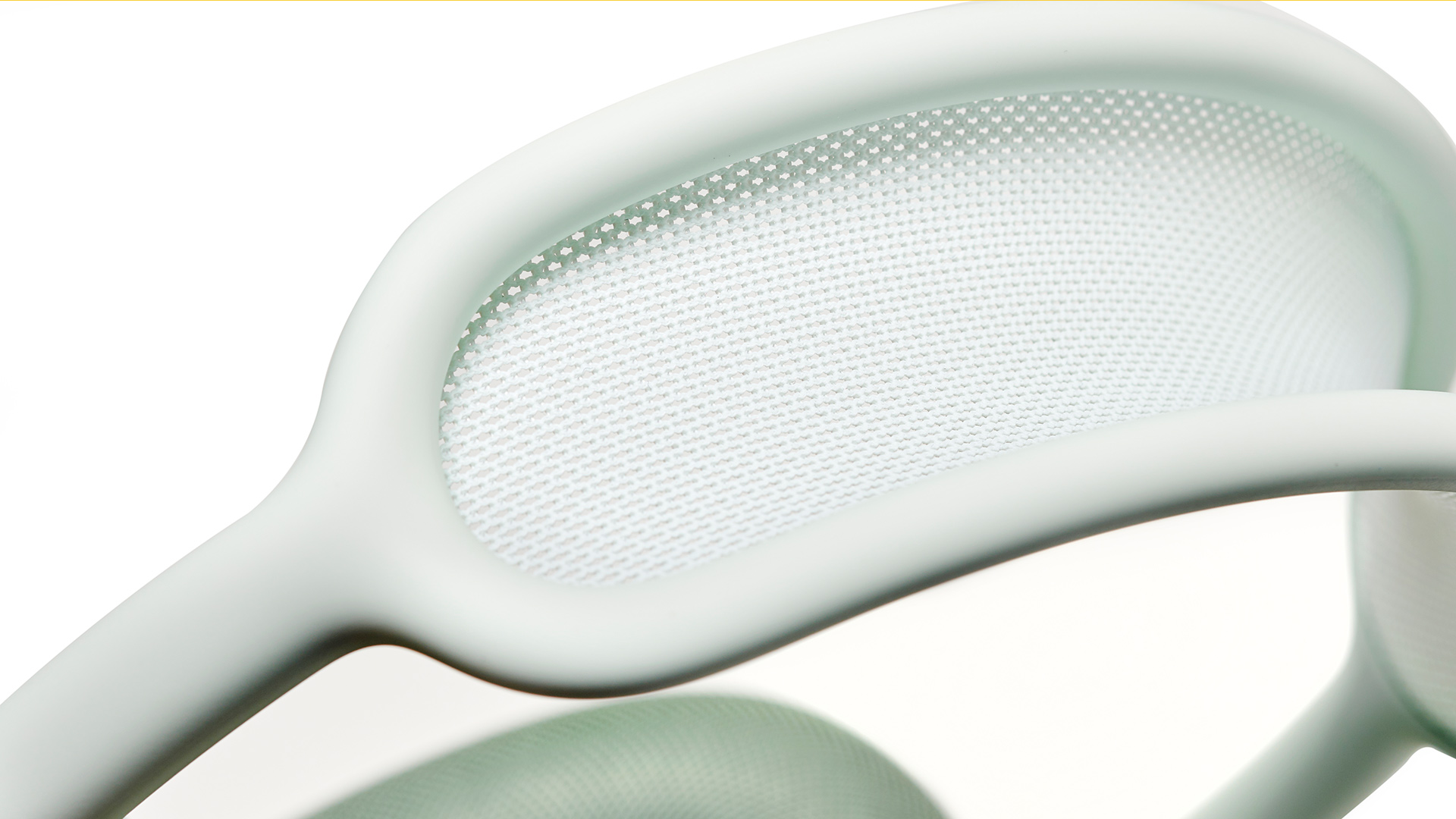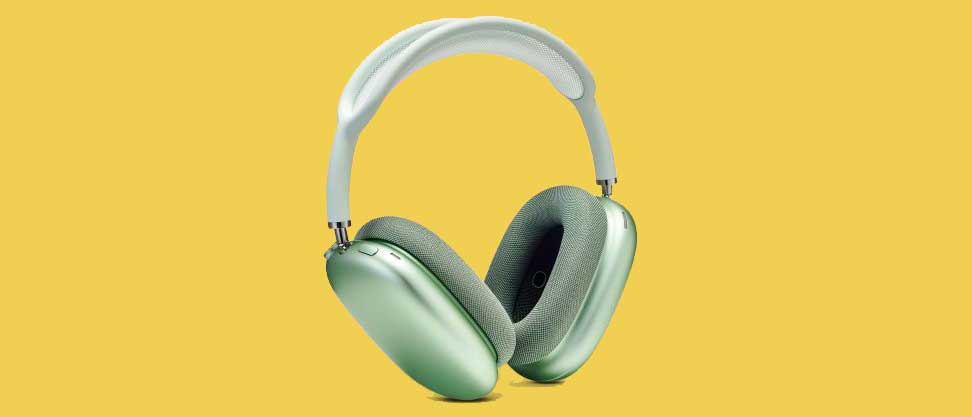Our Verdict
AirPods Max deliver sound quality that's better than the noise-cancelling competition, with some great extra features to boot. But they're not a certain buy – the fit isn't ideal for everyone, the wired connectivity is frustrating, and we don't love the battery management.
For
- Fantastic sound quality
- Elite noise cancellation
- Great Apple-friendly features
Against
- Fit isn't always comfortable
- Average battery life
- No true analogue wired connection
Why you can trust Creative Bloq
Apple AirPods Max are the company's first over-ear headphones, and are the most high-end headphones Apple has ever made. First released in December 2020, they're a real statement of audio quality in a lot of ways.
Designed around 40mm dual-magnet drivers that Apple says should produce minimal harmonic distortion, they're high-priced headphones for demanding listeners.
It's worth noting, however, that they're not high-res ready in any meaningful way. They're Bluetooth wireless headphones with only SBC and AAC communication – no LDAC or aptX is to be found here. And while they can be used wired, it's not in a way that's conducive to audiophiles, as we'll explain later.
This puts them in an odd space for audio pros – they sound simply fantastic, but the inherent latency of Bluetooth makes them less-than-ideal for some work out of the box. Latency is impressively low when connected to Apple devices, but isn't as good as being cabled. Again, though, you can use them wired, which cuts back on the delay.
Between the sound quality for general listening, the phenomenal noise cancellation (see our best noise cancelling headphones to see how they compared to the competition), and the extra Apple-friendly features – including truly impressive 3D audio and the ability to locate lost devices – they're a great buy.
But they're much more expensive than even the higher-end equivalent devices from the likes of Sony or Bose, so do they do enough to justify their extra cost to you? Even if you're able to get an Apple deal? Let's get into the details.
Apple AirPods Max review: features

One of the nice things that Apple's doing with its AirPods range is getting them all in-line when it comes to features – it's the price, design and sound quality that shift, really.
AirPods Max are Bluetooth wireless headphones, and as mentioned that's limited to SBC and AAC Bluetooth codecs, with no support for Sony's LDAC or the various aptX formats.
They offer quick pairing with Apple devices, where all you need to do is get them out of the packaging, basically, and then a pop-up appears on your phone, and that's all the effort you put in. They'll then appear as an audio source on other Apple devices that you're signed into, and will even auto-switch between, say, you iPhone and iPad if you change from listening to music on one to watching a video on the other.
They can also share audio with other AirPods (or Beats headphones with Apple's chips in), so two people could watch the same movie on a flight, say.
You get support for Apple's Find My app too, which means that if you misplace them, you can use the app to see where you last had them – and they can even 'report' their rough location to you using the Find My network of other people's iPhones.
They support hands-free Siri support (so you can say "Hey Siri", and then ask the assistant to perform lots of tasks), and can read messages to you as they come in, if you like. We don't like the interruption to our music, and choose to turn this off, but that's personal preference.
They detect when they're on your head, and will pause music if not – and enter a battery-saving state after not being used for a while.
And speaking of detecting your head, part of their music processing system is a combination of outside noise detection (for active noise cancellation) as well as monitoring their fit on your head, and adjusting the noise balance to compensate for it, aiming to ensure accuracy.
The active noise cancellation is right up there with the very best in the business. Their ability to tone low droning noises right out, and to dampen other noises to the point of near-irrelevancy is absolutely top-notch. You could quibble over the Sony WH-1000XM4 or Bose Noise Cancelling Headphones 700 slightly beating them in some areas, but honestly the difference is irrelevant. At the time of writing, they're as good as it gets.
We mentioned that slightly odd wired setup. First thing to note is that there's no 3.5mm cable included in the box – that's a £35/$35/AU$55 extra for a 1.2m cable, which is pretty damn tight for headphones that cost this much. But the main thing is that it isn't a pure analogue cable. The only wired connection on the AirPods Max is the Lightning port (which is also used to charge it), so the cable is 3.5mm on one end, and Lightning on the other.
In practice, it means that when you plug in, and audio runs through an analogue-digital conversion, because then being converted back by the DAC in the AirPods Max. There's no point trying to use this with your own DAC, because you won't get the full benefit. Similarly, any hi-res file formats would be limited to whatever conversion the cable does, so you're not exactly getting the purity of the source.
However, as mentioned, the cable does offer the lowest latency from any source, and there's no issue with its audio quality overall, so for mixing and other audio work, it does the job.
The battery life of 20 hours (with ANC on) isn't particularly impressive. You get around 50% more from the Sony WH-1000XM4, for example. There's also an odd quirk of the AirPods Max: they can't be turned off. They can only enter a very low-power state (either when you place them in the flimsy carry case they come with, or after not being used for a period of time).
This means that they're always losing battery over time. Since their launch, Apple's updates have really improved how slowly the battery drains, but we still find it frustrating that you can't just turn them off so that you know that next time you need them, they'll have juice.
Apple AirPods Max review: build/design

The build quality of AirPods Max is absolutely impeccable, as you'd expect from Apple. The headband is stainless steel (with a soft-touch finish), the earcups are aluminium, and there's a special mesh fabric when the headband actually touches your head, and over the earpads.
They come in five colours: Space Grey, Silver, Green, Sky Blue, and Pink. All colours come with at least a two-tone finish, with the headband and earcups in different hues, and then the meshes complementing those.
On the right earpad are the only two controls: a wheel (borrowed from the Apple Watch and enlarged) that's also a button, and another button. The wheel does volume and play/pause/skip controls, while the other button switches between ANC being on, or being in transparency mode.
The wheel is very satisfying, and meets that fundamental need for good music gear: to have a serious volume dial. It's also just very easy to find with your finger and control.
AirPods Max are pretty damn heavy at 384g, as compared to around 250g for both the Sony WH-1000XM4 and Bose NCH 700.
To compensate, they're designed to clamp firmly to the side of the head, which is actually really effective in distributing the weight so that this heaviness isn't really noticeable as weighing on either the top of the head or the ears. Get the fit right, and they're really comfortable for long listening periods, with no major fatigue from that weight.
However, this hard clamping style seems not to work so well for everyone. For example, this reviewer found them perfectly comfortable at launch for hours and hours of listening, but changed glasses after a few months, and found them less comfortable for long periods after. And while giving them to other people to trial, there are some who simply found them immediately uncomfortable.
Conversely, we've never met anyone who didn't find the Sony WH-1000XM4 immediately wearable. We're not saying there's a major comfort issue with the AirPods Max, just that their style of fit may not be to everyone's taste, and you should plan for a test wear if you're able.
Apple AirPods Max review: price

AirPods Max cost $549/£549/AU$899, which puts them deep into the ultra-premium end of wireless noise-cancelling headphones. You have to go to the likes of Bang & Olufsen's specialist H95 headphones to find something more expensive – even B&O's more straight equivalent model, the B&O HX, costs less than AirPods Max.
The Sony WH-1000XM4 cost around half the price of AirPods Max in the UK and US (based on retail pricing, not MSRP), and while the Bose Noise Cancelling Headphones 700 cost more than the Sony, you would still have hundreds left over compared to AirPods Max.
Now, we're not saying they're overpriced – as we've said, they're exquisitely made, and sound absolutely fantastic. But they're not twice as good as the Sony headphones.
Apple AirPods Max review: sound quality

As we've alluded to already, AirPods Max sound absolutely top drawer. They're not just deep and rich in their sound balance – they're expansive and natural, and are dynamic enough to pop just half a step ahead of the competition.
Apple likes to make sure that its headphones give a pretty accurate sound reproduction overall, and that includes making sure bass can get deep and impactful just as much as it means making sure treble is crisp and clean. The low end is under total control, able to rev up and stop in an instant – never flabby, never sloppy.
At the same time, the mid-range has no problem making itself heard away from the bass, which means that its detail gets to fully shine. We mentioned that the AirPods Max offer an expansive soundstage, and when you've got a mix of instruments across the mid-range is one area this gets to truly shine, because there's so much definition to them – so many headphones feel like a whole band is being crammed into a small space, but no such issue here. Similarly, layered voices in a choir or other vocal mix all feel like they have their own space, rather than mashing into one gloop.
It's also worth noting just how well AirPods Max handle speech outside of music. There's no over-blowing of the bass in low-register voices – they stay clear and realistic, in a natural register. It's great for listening to audiobooks/podcasts or editing them in that regard.
At the high end, it's able to elevate treble out of the mix happily, but nothing ever gets sharp or hard. No cymbal is ever subdued, no croak of a high-pitched voice is lost – everything a track has to offer.
In almost all ways, AirPods Max are just half a step ahead of the Sony WH-1000XM4. A little more expansive, a little more dynamic, a little more pop at the top end… The difference is far from night and day, but for those who really love their music, you're definitely getting more by paying more.
We've been talking about the sound quality mostly in the context of music, but all of these compliments apply perfectly to its performance with movies too. The clarity of vocals means you can even hear what's being said in Christopher Nolan movies, and the dynamic range means they're more cinematic than most actual home cinema systems – gunfire pops with total crispness, explosions have real weight to them.
But with movies, there's an extra trick too: Spatial Audio. The expansive soundstage really comes into its own here, because the position of different parts of the audio track is just wonderful. Watching movies with regular headphones just feels inadequate after. It transports you – not into the movie itself, but into a movie theatre. If you're watching on a long train journey or something, this effect is very welcome.
Spatial Audio isn't just for movies, though – Apple Music enables it for Dolby Atmos music tracks, and has a similar effect there. It's not quite as transformative as with movies, but it has the same effect of moving the sound away from the pads next to your ears and into the space around you. After that, it's down to the actual Atmos mix of the track to make the most of the extra 3D effect – some just use it for a more enveloping feeling, some use to reimagine tracks in fascinating new ways (to varying degrees of success, admittedly).
Apple AirPods Max review: should you buy it?
AirPods Max are one of the best-sounding wireless headphones on the planet – as you'd hope, for the price. They offer you a little more in terms of sound quality than the biggest competition, but you pay a lot more to get there.
However, when you add in the unique Spatial Audio 3D sound for music and movies that's available when using them with iPhone and iPad, they make an even better argument for themselves.
But we've talked about the fact that the battery life doesn't quite match the competition, and that the fit may not be quite as universally loved. And there's the unusual way they're connected wirelessly, on top.
You could buy both the Sony WH-1000XM4 and a pair of AirPods Pro for the price of the AirPods Max, giving both excellent over-ear noise-cancelling and some earbuds with the Spatial Audio features of the Max. We certainly wouldn't blame anyone who did that, and there's a strong argument it's the smart buy overall.
But for sheer audio wow, the AirPods Max are nearly unmatched in this type of headphone, and justify their price in that regard, no question.
Read more: The best Apple headphones

Thank you for reading 5 articles this month* Join now for unlimited access
Enjoy your first month for just £1 / $1 / €1
*Read 5 free articles per month without a subscription

Join now for unlimited access
Try first month for just £1 / $1 / €1
out of 10
AirPods Max deliver sound quality that's better than the noise-cancelling competition, with some great extra features to boot. But they're not a certain buy – the fit isn't ideal for everyone, the wired connectivity is frustrating, and we don't love the battery management.
Matt is Managing Editor at TechRadar.com, and previously worked on T3, MacLife and MacFormat. He's been testing technology for over a decade, working in specialist Apple publications as well general technology and creative journalism, and has charted Apple’s ups and downs since his student days (but still hopes to hear “one more thing”). By day, you can find him covering TV, audio, smart home gear and more at T3.com, as Home Tech Editor. By night, he's probably updating or pairing or installing some new piece of technology in the quest for the perfect setup.


